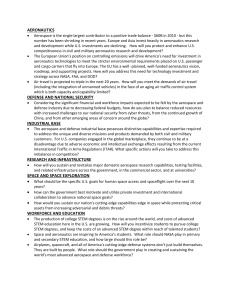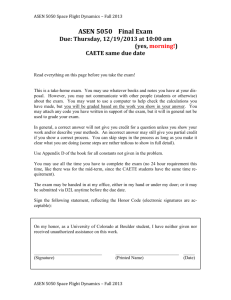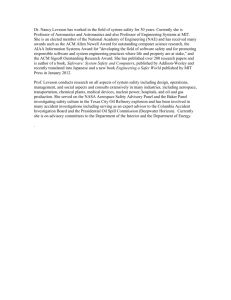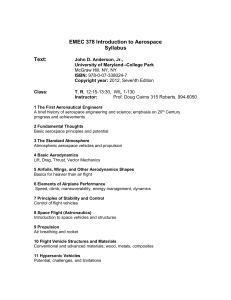The Aerospace Engineering Sciences Department of the University
advertisement
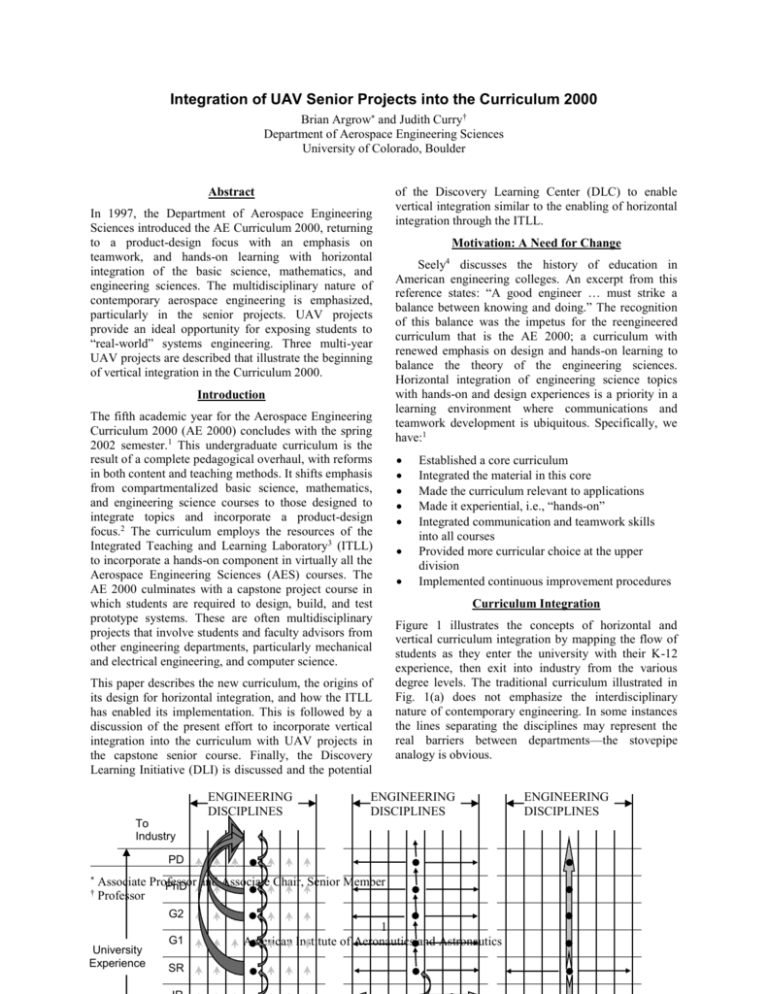
Integration of UAV Senior Projects into the Curriculum 2000 Brian Argrow and Judith Curry† Department of Aerospace Engineering Sciences University of Colorado, Boulder Abstract In 1997, the Department of Aerospace Engineering Sciences introduced the AE Curriculum 2000, returning to a product-design focus with an emphasis on teamwork, and hands-on learning with horizontal integration of the basic science, mathematics, and engineering sciences. The multidisciplinary nature of contemporary aerospace engineering is emphasized, particularly in the senior projects. UAV projects provide an ideal opportunity for exposing students to “real-world” systems engineering. Three multi-year UAV projects are described that illustrate the beginning of vertical integration in the Curriculum 2000. Introduction The fifth academic year for the Aerospace Engineering Curriculum 2000 (AE 2000) concludes with the spring 2002 semester.1 This undergraduate curriculum is the result of a complete pedagogical overhaul, with reforms in both content and teaching methods. It shifts emphasis from compartmentalized basic science, mathematics, and engineering science courses to those designed to integrate topics and incorporate a product-design focus.2 The curriculum employs the resources of the Integrated Teaching and Learning Laboratory3 (ITLL) to incorporate a hands-on component in virtually all the Aerospace Engineering Sciences (AES) courses. The AE 2000 culminates with a capstone project course in which students are required to design, build, and test prototype systems. These are often multidisciplinary projects that involve students and faculty advisors from other engineering departments, particularly mechanical and electrical engineering, and computer science. This paper describes the new curriculum, the origins of its design for horizontal integration, and how the ITLL has enabled its implementation. This is followed by a discussion of the present effort to incorporate vertical integration into the curriculum with UAV projects in the capstone senior course. Finally, the Discovery Learning Initiative (DLI) is discussed and the potential ENGINEERING DISCIPLINES of the Discovery Learning Center (DLC) to enable vertical integration similar to the enabling of horizontal integration through the ITLL. Motivation: A Need for Change 4 Seely discusses the history of education in American engineering colleges. An excerpt from this reference states: “A good engineer … must strike a balance between knowing and doing.” The recognition of this balance was the impetus for the reengineered curriculum that is the AE 2000; a curriculum with renewed emphasis on design and hands-on learning to balance the theory of the engineering sciences. Horizontal integration of engineering science topics with hands-on and design experiences is a priority in a learning environment where communications and teamwork development is ubiquitous. Specifically, we have:1 Established a core curriculum Integrated the material in this core Made the curriculum relevant to applications Made it experiential, i.e., “hands-on” Integrated communication and teamwork skills into all courses Provided more curricular choice at the upper division Implemented continuous improvement procedures Curriculum Integration Figure 1 illustrates the concepts of horizontal and vertical curriculum integration by mapping the flow of students as they enter the university with their K-12 experience, then exit into industry from the various degree levels. The traditional curriculum illustrated in Fig. 1(a) does not emphasize the interdisciplinary nature of contemporary engineering. In some instances the lines separating the disciplines may represent the real barriers between departments—the stovepipe analogy is obvious. ENGINEERING DISCIPLINES To Industry PD † Associate Professor PhD and Associate Chair, Senior Member Professor G2 University Experience G1 SR 1 American Institute of Aeronautics and Astronautics ENGINEERING DISCIPLINES Figure 1 Schematic illustrating curriculum structure and the ideas of horizontal and vertical integration. Horizontal integration, illustrated in Fig. 1(b), may be accomplished in several ways. The most fundamental integration occurs when the topics and methods of basic science and mathematics courses are connected to engineering science topics to remove disconnects that often occur. The engineering science topics are presented in a continuum that emphasizes topical interdependence and overlap. At a higher level, this integration may cross departmental boundaries with shared facilities and possibly interdepartmental courses. Horizontal integration was the central theme of the Integrated Teaching and Learning Initiative, that preceded the construction of the ITLL. A vertically integrated curriculum, as shown in Fig. 1(c), is designed to foster interaction of students across various levels of preparation and classes. The central focus of the DLI is to provide students at all levels with hands-on research experience in multi-year, sponsored projects. The research teams will combine students of all levels with faculty, research associates, corporate mentors, and corporate sponsors. This vertical integration will allow mentoring at all levels and educate students for working in research teams. The DLC is the building in which DLI-based activities will be conducted. This facility is scheduled to open for tenants in August 2002, with an official dedication scheduled for October 2002. The Aerospace Engineering Curriculum 2000 The curriculum shown in Fig. 1(b) illustrates horizontal integration. In the AE 2000, outlined in Table 1, this begins in the freshman year with the GEEN 1400 Freshman Projects course. This general engineering course crosses departmental lines with its multiple sections taught by faculty from the various departments in the College of Engineering and Applied Sciences. Its purpose is to introduce students to the design process with an emphasis on teamwork. The ASEN 2000 course series in the sophomore year emphasize topical integration of the engineering sciences. The sub-disciplines previously taught in the typical, compartmentalized fashion, are combined to reinforce the continuum of engineering science concepts, problem formulation, and operational skills, with the basic concepts and operational skills of the basic science and mathematics courses. This is presented in a format that emphasizes hands-on learning and product design. These courses form the heart of the AE 2000, following is a brief description of 2000-series courses: ASEN 2001: Introduction to Statics, Structures, and Materials, introduces the fundamental analytical tools for statics and structural analysis in the context of the physics of aerospace materials. Topics include force/moment equilibrium, truss analysis, Table 1 Aerospace Engineering Curriculum 2000 Year Semester Credit Hrs Prerequisite / Co-Requisite (CR) 2 American Institute of Aeronautics and Astronautics Fall APPM 1350 ASEN 1000 CHEM 1211 CHEM 1221 GEEN 1400 FRESHMAN Spring APPM 1360 PHYS 1000 Fall APPM 2350 ASEN 2001 ASEN 2002 SOPHOMORE Spring APPM 2380 ASEN 2003 ASEN 2004 Fall ASEN 3111 ASEN 3112 ASEN 3113 PHYS 1120 JUNIOR Spring ASEN 3128 ASEN 3200 ASEN 3300 WRTG 3030 Fall ASEN 4013 ASEN 4018 SENIOR Calculus 1 for Engineers Intro to Aerospace Engineering* General Chemistry for Engineers General Chemistry for Engineers Engineering Projects Humanities/Social Science Elective Semester Credit Hours 4 1 3 2 3 3-5 15-18 C or better in MATH1100 Freshman in Aerospace Engineering One year high school chemistry One year high school chemistry Freshman in Engineering Variable Calculus 2 for Engineers General Physics 1 Computing Elective** Humanities/Social Science Elective Semester Credit Hours 4 4 3-4 3-5 14-17 APPM 1350 CR APPM 1350 Variable Variable Calculus 3 for Engineers Aerospace 1 Aerospace 2 Humanities/Social Science Elective Semester Credit Hours 4 5 5 3-5 17-18 APPM 1360 APPM 1360, CHEM 1211/1221, PHYS 1110 APPM 1360, PHYS 1110 Variable Ordinary Differential Equations Aerospace 3 Aerospace 4 Humanities/Social Science Elective Semester Credit Hours 4 5 5 3-4 17-18 APPM 2350 APPM 2350, ASEN 2001; CR APPM 2380 APPM 2350, ASEN 2002 Variable Aerodynamics Structures Thermodynamics & Heat Transfer General Physics 2 Semester Credit Hours 4 4 4 4 16 APPM 2350, ASEN 2002, ASEN 2004 ASEN 2001; CR APPM 2380 APPM 2350, ASEN 2002 PHYS 1110 Aircraft Dynamics Orbital Mech/Att Determ & Control Electronics & Communications Writing Science & Society Humanities/Social Science Elective Semester Credit Hours 4 4 3 3 3 18 APPM 2380, ASEN 2002, ASEN 2004 APPM 2380, ASEN 2003, ASEN 2004 APPM 2380, ASEN 2003, PHYS 1120 Junior Standing in Engineering Variable Foundations of Propulsion Senior Projects 1 Professional Area Electives Free Elective Semester Credit Hours 3 4 6 3-4 16-18 APPM 2380, ASEN 3113 Senior standing in Aerospace Engineering Variable Variable Spring ASEN 4012 ASEN 4028 Aerospace Materials 3 APPM 2380, ASEN 3112, ASEN 3113 Senior Projects 2 4 ASEN 4018 Professional Area Electives 6 Variable Free Elective 3-5 Variable Semester Credit Hours 16-18 *Not required, may be applied to Free Elective Requirement **Programming experience is an implicit prerequisite for ASEN courses 2000-level. Recommend GEEN 1300-3, or CSCI 1300-4. Table 2 ASEN 2002 Introduction to Thermodynamics and Aerodynamics Classwork (3 hr/week) Experimental Labs (2 hr/week) Design Labs (2 hr/week) 3 American Institute of Aeronautics and Astronautics Exams Homework (15 hr/week) Week 1 Concepts/Topics Lab safety and procedures Basic concepts of thermodynamics Problem Set Reading P1 C 1-2 C2 2 3 4 Properties of pure substances 5 6 Conservation of energy: the first law for closed systems and control volumes (flow systems) E1: Basic Temperature Measurement and Thermodynamic Efficiency Thermocouples Reference temperature: real and software compensation Efficiency of a hairdryer 9 10 13 16 P3 C2 C3 C 3, 4 P4 E2: Bernoulli’s Equation, Flow Measurements, and LowSpeed Wind Tunnel Testing Introduction to aeronautics, aerodynamic forces, and dimensional analysis 1-D incompressible flow C4 S 1-3 Flow meter comparison Intro to wind tunnel testing Pitot static probe and flow speed measuring pressure distribution on a circular cylinder.l EX4 P5 S 4-6 S7 1-D compressible flow Two-dimensional flow: lift and drag 14 15 EX2 EX3 11 12 P2 C3 D1: Large Inflatable Spacecraft Radio Antenna 7 8 EX1 Viscous flow D2: Sounding Rocket, X Prize E3: Pressure and Lift Measurements, Viscous Flows EX5 P6 EX6 P7 S7 S8 S8 S 10 How wings produce lift Viscosity measurement and comparison EX7 P8 S 10 Summary & Review beam theory, stress and strain, material structure, alloy phase diagrams, polymers, ceramics, composites, and aerospace structural design. ASEN 2002: Introduction to Thermodynamics and Aerodynamics, introduces the fundamental concepts and principles of thermodynamic and fluid dynamic systems. The focus is in areas of general importance to the aerospace engineering discipline. The primary goal is the synthesis of basic science (physics), mathematics, experimental methods for quantitative and qualitative analyses and design of general aerospace technology systems. ASEN 2003: Introduction to Dynamics and Systems, introduces the principles of particle and 2D rigid body dynamics, vibrations, systems, and controls. The topics covered include kinematics, kinetics, energy methods, system modeling, and simple feedback control. ASEN 2004: Aerospace Vehicle Design and Performance, introduces the design and performance analyses of aircraft and spacecraft. Aircraft topics include wings, propulsion, cruise performance, stability and control, structures, and preliminary design. Spacecraft topics include orbital mechanics, orbit and constellation design, rocket equation and staging, launch systems, and spacecraft subsystems. Table 2 is the schedule used in ASEN 2002 for the fall 2001 semester. This illustrates the topical breakdown along with typical experimental and design laboratory activities. Table 3 shows the structure of the ASEN 2000 courses, based on a two-week curriculum module. Table 3 ASEN 2002 Bi-Weekly Curriculum Block 4 American Institute of Aeronautics and Astronautics Week 1 2 Mon 110 min Expt. & Design Lab Tue 75 min Disc. & Lect. Hwk Soln & Summary Wed 110 min Expt. & Design Lab Thu 75 min Group Exerc. & Lect. The AE 2000 was launched with the opening of the ITLL, and this facility remains critical to insure the Exam There are 11 defined outcomes for the AE 2000. It is expected that a graduate of the curriculum will demonstrate the capabilities enumerated here: O1 Professional context and expectations (ethics, economics, business environment, etc.) O2 Current and historical perspective O3 Multidisciplinary, systems perspective O4 Written, oral, graphical communication ability O5 Knowledge of key scientific/engineering concepts O6 Ability to define and conduct experiments, use instrumentation O7 Ability to learn independently, find information O8 Ability to work in teams O9 Ability to design O10 Ability to formulate and solve problems O11 Ability to use and program computers Combined with the specific learning goals of each course, assignments are designed to produce these outcomes. Student grades indicate the degree to which they can demonstrate the required abilities. A grading and assessment tool has been piloted that allows students and faculty to track individual performance for a comprehensive view of strengths and weaknesses. This information is used in a year-end assessment of each course to continuously tune content and delivery. outcomes enumerated earlier. The 34,000 square-foot building has three levels. The top level has two active classrooms for the GEEN 1400 Freshman Projects courses. The lower two levels are dominated by laboratory plazas. Figure 2 shows the layout of the plaza on the main level, photographed from the top level. Each plaza nominally contains 18 laboratory stations and each station contains two networked PCs with software that includes Labview, MATLAB, Microsoft Office, and Solid Works, among the many other packages. In addition to the virtual instruments available with Labview, each station is equipped with an oscilloscope, function generator, and other “real” electronic instruments. Multichannel data acquisition boards and military connectors from each computer allow experimental modules to be rolled up to the individual stations. The ITLL: Enabling Horizontal Integration The College-wide Integrated Teaching and Learning Initiative began in 1992, culminating with the dedication of the laboratory in the fall of 1997. The program plan, developed before the construction of the laboratory, is embodied in the “ITLL Wheel,” shown in Fig. 2. Figure 2 The ITLL wheel that emphasizes the its multidisciplinary mission. Figure 3 Overlook of one of the ITLL plazas and labstations. 5 American Institute of Aeronautics and Astronautics In the 2000-series laboratories, teams are rotated through activities such that they are always either performing experiments, preparing for experiments, or conducting design related activities (such as design interviews with the faculty teaching team). Each team of approximately four students has their own dedicated labstation. When not used for data acquisition, the labstations become workstations for the design portion of the laboratory exercises. The hands-on and design experiences continue in the junior-level courses. The emphasis on experimental activities is most intense in ASEN 3300 Electronics and Communications, however all the junior courses have required experimental laboratory and design content. UAVs. Serious operational issues have arisen during these Arctic missions. Especially serious is the problem of in-flight icing. Figure 4 shows an Aerosonde UAV parked on the Arctic ice at the conclusion of a mission. AES graduate and undergraduate students have been involved with analyzing the icing problem and investigating deicing systems. In August 2001, these same scientists and engineers were part of the operations teams for the Convection And Moisture Experiment (CAMEX-4) sponsored by the Earth Science Enterprise of NASA. The Capstone Course: Senior Projects The capstone experience in the AE 2000 is a yearlong, two-course sequence that implements a “design, build, and test” philosophy. The fall semester course ASEN 4018 focuses on design synthesis. The course terminates with a comprehensive design review (CDR) in preparation for the practicum of the spring semester course ASEN 4028. In this course the students begin with the CDR from the previous semester, then focus on the build and test phase of the project. The level of success (grade) of a project is generally determined by the degree to which project milestones are achieved, and the how the tests are conducted and the results analyzed. UAVs provide an excellent opportunity for systemsoriented senior projects. Relatively low cost, commercial off-the-shelf (COTS) components allow the design and construction of high-performance UAVs. Innovations continue in airframe design and propulsion. However, miniaturized sensors and navigation hardware, combined with high-speed onboard processors and wide-band communications have revolutionized the capabilities of undergraduates. The result is relatively low-cost UAV platforms that provide relevant capstone design projects and enable undergraduates to develop systems that support university research programs. Just as the ITLL has enabled horizontal integration, the DLC will help to enable vertical integration. Three multiyear, interdisciplinary UAV projects that exemplify vertically integrated senior projects are now described. Aerosonde5 Since late-summer 2000, Aerosonde™ robotic aircraft have been deployed from Barrow, Alaska for lowaltitude remote sensing. For this project, AES atmospheric scientists and aerospace engineers are working with Aerosonde engineers to acquire meteorological and climatological data with in situ measurements and remote sensing from the Aerosonde Figure 4 An Aerosonde UAV resting on the Arctic ice after a remote sensing mission. The Aerosonde research has spawned several senior projects. The first senior team worked with a Ph.D. candidate to investigate and design a deicing system. At the conclusion of their course sequence, the seniors attempted to demonstrate several deicing schemes, none of which was determined to be suitable for implementation. A second group designed and constructed a catapult launch system for the Aerosonde UAV. Presently, in preparation for their senior project course, a group of junior-level students have begun to reexamine the deicing problem and are also looking at design modifications to the Aerosonde airframe that may enable it to carry multiple drop-sondes for a proposed Antarctic mission. In the fall they will begin the ASEN 4018-28 sequence with the continued support of the graduate research assistants. TornadoChaser The TornadoChaser is a portable, remotely-piloted vehicle (RPV) that will operate in severe “pretornadic” thunderstorms. The prototype UAV is shown in Fig. 5. This project began in the fall of 1999 with primary funding from the National Severe Storms Laboratory (NSSL) of the National Oceanographic and Atmospheres Administration (NOAA). Onboardsensors and navigation hardware will receive flight commands and transmit flight and in situ meteorological data. The navigation systems include a solid-state gyro and magnetometer along with a differential GPS system. Communications between the 6 American Institute of Aeronautics and Astronautics RPV and the ground station is through wireless modems with a range of more than 20 miles. Missions will be designed to penetrate the region associated with the radar “hook echo” in supercells, the particularly nasty variety of severe thunderstorms that often produce tornadoes. (The hook echo is generally a precursor of tornado formation.) particularly the canard mount and warped control surfaces. It was also determined that this instability was not detected because of deficiencies in the wind tunnel test plan. The vehicle is presently being repaired before a more thorough round of wind tunnel tests are conducted. Figure 5 The TornadoChaser UAV shortly before the initial flight test. As an example of technology transfer and multiple uses of robust designs, the Virtual Cockpit, in development for remote-piloting of the TornadoChaser, was adapted as a graphical user interface for the Aerosonde flight simulator. A captured frame of the Virtual Cockpit, during the simulation of an Aerosonde CAMEX-4 flight, is shown in Fig. 6. This system shows the vehicle heading and orientation in the left panel and its instantaneous location is projected onto a map on the right. In this particular case, the map shows the aircraft’s location with respect to the runway. System dials and gauges that report the aircraft health and performance are readily visible. The interdisciplinary nature of this project has attracted the attention of seniors from mechanical and electrical engineering, as well as computer science seniors. During the past year, the team started with two aerospace engineering and two computer science undergraduates, one electrical engineering undergraduate, and two aerospace engineering graduate students. The graduates received independent study credit for their work, while arrangements were made such that the non-aerospace engineering students received credit for their capstone courses. The first flight test of the TornadoChaser was conducted in May 2002, resulting in a crash that produced minor damage. The crash investigation determined that the unexpected roll instability was the result of construction asymmetry in the airframe, Figure 6 Virtual Cockpit adapted to replay Aerosonde missions TUAV The X-BW Devil Ray Tactical UAV (TUAV) is a flight testbed vehicle for tactical unmanned systems. This project, primarily funded by General Dynamics Corporation (Systems Divison), started in the fall of 2000. Figure 7 shows the unconventional “box wing” design of this RPV and Fig. 9 shows students during the construction process. With an empty weight of 75 pounds, a small gas turbine engine that provides an endurance of approximately one hour with a cruise speed of 56 knots, and a payload capacity of 35 pounds. GPS, gyro, and pitot data are telemetered to a ground receiving station. As with the TornadoChaser, the interdisciplinary nature of this project has attracted students from several engineering departments. It has also involved graduate students and pre-senior undergraduates. Ground tests (taxiing and communications) were conducted in December 2001 and March 2002. Figure 9 shows the TUAV during these intial taxi tests. An initial flight test was conducted in April 2002 at the El Mirage Dry Lakebed in southern California. The vehicle is shown parked on the lakebed shortly before its initial flight. A NASA Dryden test pilot was at the controls for the initial flight. Unfortunately, he could not maintain control of the TUAV and it crashed after several seconds of flight. Results of the crash investigation are pending. 7 American Institute of Aeronautics and Astronautics Figure 9 Initial taxi tests for the TUAV. Figure 7 TUAV dimensions. Figure 10 The TUAV prepared for initial flight test. Conclusions The Aerospace Engineering Curriculum 2000 has been in operation for five years. The focus on horizontal integration is now in place at all levels. The outcomes based evaluation provides a detailed breakdown of students strengths and weaknesses and this collective information allows for continuous review and improvement of the courses. Figure 8 Students laying out the composite main wing of the TUAV. The UAVs in the AES program represent a class of relatively low-cost systems that display a broad range of capabilities. The availability of low-cost, commercial-off-the-shelf components allows the design, construction, and testing of major subsystems within the one-year time frame of the senior projects courses. The vertical integration of these projects enables students at lower grade levels to begin working on multiyear projects earlier, to provide needed continuity through the senior projects course. Vertical integration, focused on the capstone Senior Projects course, has begun. UAV projects appear ideal since they involve subsystem integration requiring interdisciplinary teams and because they are typically multiyear projects, students have an opportunity to become involved prior to their senior year. The high visibility of the UAV projects excites students early so they become involved prior to their senior year. This also makes the transition from an outgoing senior group to an incoming group much easier, since the incoming students are already familiar with the project. Because these type projects are often associated with sponsored research, graduate students are also integrated into the overall project teams. As the Integrated Teaching and Learning Laboratory enabled horizontal integration in the AE 2000, Discovery Learning Center (to be dedicated October 2002) will facilitate vertical integration. The Arctic research project that presently employs Aerosonde UAVs will be one of the first tenants as part of the Space Experiments Institute, that will be located in the Discovery Learning Center. It will continue to be a model project for vertical integration References Seebass, A. R. and Peterson, L. D., “Aerospace Engineering 2000: An Integrated, Hands-On 1 8 American Institute of Aeronautics and Astronautics Curriculum,” Frontiers of Computational Fluid Dynamics 1998, ed. Caughey, D. A. and Hafez, M. M., World Scientific, pp. 449-464 (1998). Argrow, B., “Proactive Teaching and Learning in the Aerospace Curriculum 2000,” Proceedings of the 2002 ASEE Annual Conference and Exhibition, Montreal, Canada, June 2002. Carlson, L. E. and Sullivan, J. F., “The Integrated Teaching and Learning Program: A Pioneering Learning Environment for 21st Century Engineering Education,” Proceedings of the Engineering Foundation Conference: Realizing the New Paradigm for Engineering Education, Baltimore, MD, June 1998, pp. 110-120. 3 Seely, B. E., “The Other Re-engineering of Engineering Education, 1900-1965,” Journal of Engineering Education, 88 (3), Jul. 1999, pp. 285-294. 4 5 Holland, G.J., Webster, P.J., Curry, J.A., Tyrell, G., Gauntlett, D., Brett, G., Becker, J., Hoag, R, and Vaglienti, W., “The Aerosonde Robotic Aircraft: A New Paradigm for Environmental Observations,” Bull. Amer. Met. Soc., 82 (5), pp. 889-901 (2001). Cole, S., “Science and the Citizen: Robots in the Sky,” Scientific American, Nov. 2000. 6 9 American Institute of Aeronautics and Astronautics

